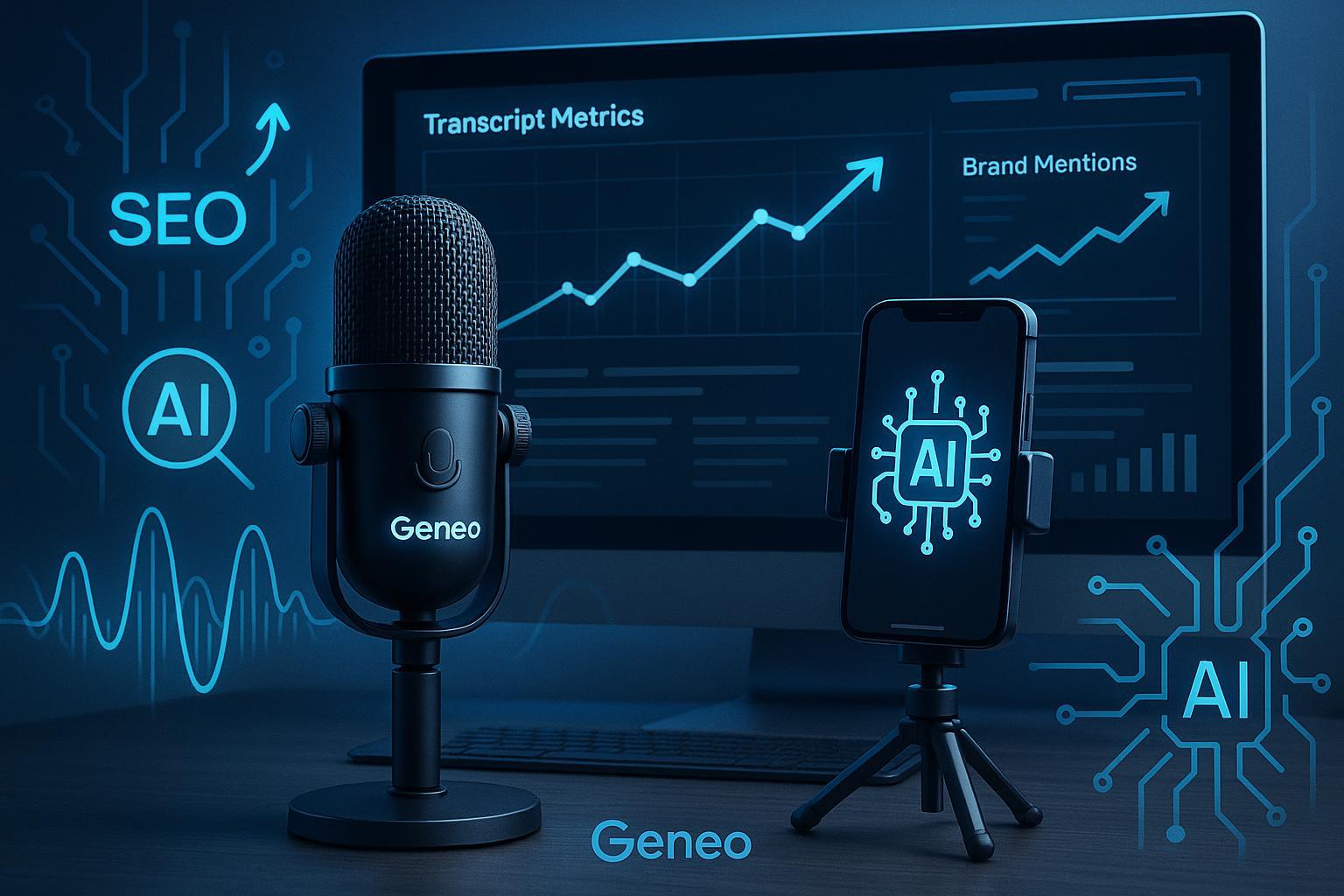Best Practices for AI Search Optimization of Podcast & Video Transcripts — 2025
Discover proven 2025 best practices for optimizing podcast and video transcripts for AI/LLM search visibility. Learn advanced tactics, workflow automation, and how Geneo empowers real-time analytics for marketing teams to boost rankings across ChatGPT, Gemini, and Google AI Overview.


As we advance into 2025, the landscape for podcast and video content discoverability has shifted dramatically. AI search platforms—driven by powerful LLMs like ChatGPT, Gemini, and Google AI Overview—now process, rank, and recommend spoken-word content based on transcript quality, semantic SEO, and contextual depth. For marketing teams and brand managers, optimizing transcripts is no longer optional: it’s foundational for digital visibility and brand impact.
In this detailed guide, I’ll break down the proven best practices for maximizing recognition and ranking of podcast and video transcripts by modern LLMs, with real-time workflow integration using the Geneo platform. Let’s dive into how expert marketers achieve top results in 2025, turning insights into rapid, measurable gains.
The New Paradigm: Why Transcripts Matter More Than Ever (2025)
Today’s AI search systems parse transcripts not just for accessibility but as the primary source for indexing podcast/video content. Well-structured, optimized transcripts fuel:
- Rich media search results and AI Overviews
- Enhanced entity and brand mentions visible in ChatGPT, Gemini, Perplexity, and more
- Contextual recommendations, semantic passage retrieval, and improved citation rates
If transcripts are missing, poorly formatted, or misaligned with current SEO, AI-powered discovery tanks—especially as LLM-driven search (Google AI Overview, ChatGPT answers) approaches 50%+ share of podcast/video content referrals (DataStudios, 2025).
Actionable Transcript Optimization Workflow for LLM Search
1. Transcription Quality: Foundation of Discoverability
- Best-in-Class Tools: Use advanced ASR platforms (Descript, Sonix, Whisper) for high-fidelity, diarized, speaker-tagged transcripts (RapidInnovation).
- Pre/Post Editing: Always clean audio (noise reduction, gain leveling) before transcription. Post-process with AI editing to fix mishears, add correct speaker labels, and ensure conversational clarity.
2. Transcript Structuring: Align for AI Parsing
- Headings, Timestamps & Actionable Segments: Break transcripts into topic sections, Q&A blocks, guest highlights. Include timestamps for chapter context, especially for Gemini and YouTube indexing.
- Speaker Attribution: Ensure conversation flow is clear—LLMs score transcripts higher for searchable context when speakers are tagged.
3. Semantic SEO & Keyword Integration
- Topic Clustering: Integrate relevant long-tail keywords and contextual cues naturally (“brand name + product + trending topic + guest name”).
- Conversational Tone: Write for humans and machines, using natural language and question/answer sections for featured snippets (M8L).
4. Metadata & Structured Data: Schema Markup for AI Indexing
- Schema.org: Apply PodcastEpisode and VideoObject markup; include the
transcriptproperty, chapters, guest metadata.- Example: JSON-LD schema for a podcast episode (see schema.org PodcastEpisode).
- llms.txt: Maintain updated llms.txt on your domain to manage AI crawler access; include podcast/video URLs and sitemap.
5. Cross-Platform Syndication & Distribution
- Publish With Audio/Video: Always pair transcripts directly under the media asset on your site. Syndicate via Apple Podcasts, Spotify, YouTube, TikTok, LinkedIn with accessible transcripts, using platform-specific fields or descriptions where schema isn’t available.
- Backlink Strategy: Distribute transcripts for citation in industry directories and quotable references (podcast blogs, guest sites, press releases).
6. Automation Pipelines & Continuous Iteration
- Workflow Automation: Connect ASR → CMS → Schema → llms.txt update using Zapier, Make, or custom scripts. Track transcript changes and automate benchmarking in AI search rankings.
- Iterative Optimization: Set regular review cycles—every new episode triggers a transcript audit, optimization update, and analytics review.
Measuring Impact: Analytics, Benchmarking & Feedback Loops
LLM & AI-Driven Metrics to Track
-
Transcript Visibility Score: How often is your transcript referenced or cited in ChatGPT, Gemini, or Google AI Overview answers? Use direct query diagnostics and third-party dashboards (Semrush AI Toolkit, Authoritas).
-
Brand/Entity Mentions: Geneo’s real-time tracking pinpoints every AI-delivered mention of your brand or content—across multiple platforms.
-
AI Referral Traffic: Quantify traffic or engagement originating from LLM-driven recommendations and answers.
-
Sentiment & Context Analysis: Use Geneo’s sentiment engine to assess how your transcript is contextualized in AI answers—positive, neutral, or negative.
-
Pre/Post Optimization Metrics: Log changes in citation frequency, engagement, rankings before and after transcript updates. Example:
Metric Pre-Optimization Post-Optimization AI Overview Quotes 2/mo 11/mo ChatGPT Mentions 1/mo 9/mo Podcast Downloads 3000 3850 Brand Sentiment Score -0.1 +0.4 Metrics from composite AI dashboard and Geneo analytics reports.
Real-World Optimization Loop: Geneo in Action
Let’s walk through a typical best-practice cycle for a leading brand podcast team leveraging Geneo:
- Transcript Upload: New episode goes live, high-quality transcript is posted on the site with full semantic markup.
- AI Visibility Audit: Geneo automatically detects the episode on ChatGPT, Gemini, and Google AI Overview—measuring mentions, sentiment, and ranking position.
- Content Suggestions: Geneo’s AI reviews the transcript, benchmarking against top-performers and providing targeted recommendations (keyword clusters, FAQ additions, reordering segments for context).
- Continuous Improvement: The team implements updates, logs metrics, and re-monitors. If specific LLMs consistently miss the show, Geneo flags gaps and suggests schema/SEO tweaks, even offering sample llms.txt entries if needed.
- Historical Comparison: Over weeks, Geneo visualizes trends—showing direct growth in LLM citations, share of voice in AI results, and sentiment improvements. Dashboards support easy reporting to stakeholders and guide next step iterations.
Geneo’s advantage? All these insights and workflow triggers are delivered in one place—no siloed manual analysis, no lag waiting for third-party data. Try Geneo to accelerate transcript ROI and stay visible in the new AI-powered podcast/video search world.
Common Pitfalls & Troubleshooting (2025 Edition)
- Audio Quality Issues: Poor sound = error-prone transcripts. Fix with pre-recording checks, noise filters, and editing before transcription (Notta.AI).
- Inconsistent Formatting: Missing timestamps, headers, or speaker tags confuse LLMs—always use clear hierarchy and labels.
- Neglected Schema or llms.txt: Skipping structured data means missed AI visibility; always update markup and enable AI crawlers.
- Keyword Stuffing: Inorganic keyword cramming kills both UX and LLM parsing. Favor natural, contextual Q&A integration over keyword density.
- Lag in Reviewing Trends: Failing to monitor real-time analytics leaves opportunities untapped. Set reminders with platforms like Geneo for automatic feedback.
Advanced Tips, Expert Insights & What’s Next
“AI is rewriting the SEO playbook, but not rendering it obsolete. The winners in 2025 will be those who adapt—leveraging AI to advantage and ensuring their content remains visible in the era of generative search.” —Barry Schwartz, SEO Industry Leader
- Leverage FAQ & Q&A Sections: These boost direct answer rates in LLMs, earning more featured snippet placement.
- Experiment Across Platforms: Each AI (Google Gemini, ChatGPT, Perplexity) parses differently—monitor via Geneo, tune for cross-channel success.
- Automate Your Audit: Build a workflow using Zapier/Make to auto-check transcript accuracy, schema deployment, and llms.txt status with every new episode. Geneo’s API can trigger real-time audits and optimization prompts.
- Document Iteration: Keep before/after logs and dashboard screenshots for every transcript update—vital for stakeholder buy-in and continuous improvement.
- Stay Ahead of Privacy & Discovery Shifts: As AI content indexing standards and privacy regulations evolve, monitor updates from Wix SEO Tips for 2025, Google’s developer docs on podcast structured data, and your favorite LLM platforms directly.
Downloadable Resources & Workflow Templates
Takeaway: Make Every Transcript Count—Iterate, Measure, Win
The best marketing teams know that winning in AI search is all about iterate-measure-improve. In 2025, transcript optimization isn’t just about being found—it’s about being understood, cited, recommended, and driving real traffic and brand share of voice on every major platform.
Ready to dominate the new AI-powered podcast and video search? Integrate Geneo into your workflow for real-time monitoring, actionable optimization, and evidence-driven growth. Start your free trial here.
References:
- Podcast SEO: Rank Higher & Get Found on Google in 2025 – Descript
- AI Search Content Optimization: The Complete Guide (2025) – Beeby Clark Meyler
- G2 Deep Dive: Gemini vs ChatGPT
- Quill Podcasting: Branded Podcast Optimization for LLMs
- Page One Power: Video SEO Tips for 2025
- Schema.org PodcastEpisode
- Nav43: llms.txt in AI SEO
- Geneo





